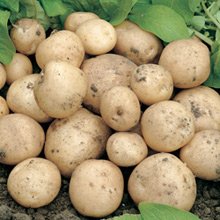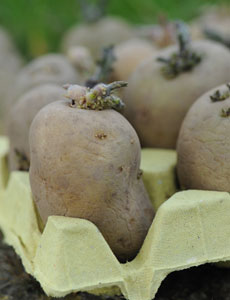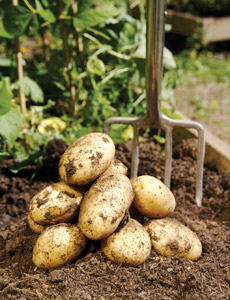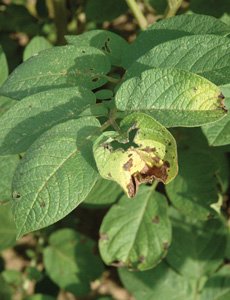How To Grow Potatoes in the Ground

Preparing the site
When growing your own potatoes choose an open position in full sun on fertile, well drained soil. Avoid soil where potatoes have grown for two years in succession as this will increase the risk of disease. A slightly acidic soil is preferable but not essential as potatoes will tolerate a wide range of soils. When growing potatoes on more alkaline soils, apply sulphur to the top of the potato ridge after planting. Applying sulphur maximizes the yield and deters skin blemishes like Common Scab that are particularly troublesome in alkaline conditions.
Begin preparing the planting site well in advance (November/ December) to allow the soil to settle before planting potatoes. Remove all weeds and dig the site thoroughly and deeply, lifting out any large stones, and incorporating plenty of well rotted organic matter and high potash fertiliser.

Chitting Potatoes
Seed potatoes, particularly earlies and second earlies, benefit from 'chitting' prior to being planted. This process encourages strong shoots to sprout over several weeks to encourage faster growth and heavier crops once they in the ground.
From late January/ February, chit your seed potatoes by setting them out in seed trays, shallow boxes or empty egg cartons in a cool, bright, frost free position (10C/ 50F) to allow them to sprout. You will notice that the immature 'chits' are all at one end (called the rose end). Place the rose end upwards. Sturdy 'chits' will form and should attain up to 25mm (1") in length.
Cutting Seed Potatoes
Seed potatoes are normally about the size of a chickens egg, but will often vary in size. Dont be concerned if you receive different sized seed potatoes - they will all grow equally well.
In fact, during the 2nd World War it was common practice to cut larger seed potatoes in half or even smaller divisions to make the seed potatoes go further. The cuts should be left to dry out for 3 or 4 days before planting in the usual way. Provided that each piece has an eye or two for the new growth to develop, these tuber divisions will still crop well. Nowadays, seed potatoes are cheap and widely available so there is generally no need to do this unless you receive particularly large seed potatoes with lots of eyes.
How To Plant Potatoes
Planting times are largely dependent on weather, soil conditions and regional variations but the table below is a general guide on when to plant potatoes. Dig a trench to a depth of about 10cm (4") and place the seed potatoes into the trench with the rose end facing upwards. Fill the trench with soil to cover the potatoes. An application of potato fertiliser can be scattered along the top of the trench if required.

Aftercare
It is important to earth up potato crops as the shoots emerge above ground, to protect them from frosts which blacken the shoots and delay production. Simply draw some soil over the top of the shoots to cover them again.
First early and second early crops particularly require plenty of water during prolonged dry weather especially when tubers are starting to form.
When the stems reach a height of 23cm (9") above ground they should be earthed up again to prevent tubers near to the soil surface from turning green.

Harvesting
Lifting times will vary depending on the growing season, weather conditions at harvest time and the size of tuber you want. However the table above provides a rough guide for each crop type. Start to harvest first earlies as 'new potatoes' when the plants begin to flower, approximately 10 weeks from planting. Tubers will generally become larger the longer their growing period.
Maincrop varieties are usually left for at least two weeks after the leaves and haulms (stems) have withered, to allow the skins to set. Cut down the stems with secateurs to just above soil level as the leaves wither and yellow, or if they show signs of blight. After harvesting, leave the tubers on the soil surface for a few hours to dry and cure the skin. Once dry store them in paper or hessian sacks in a dark, cool but frost free place. Avoid storing in polythene bags as potatoes will 'sweat' and rot.
Second Cropping Potatoes
In the UK, second cropping potatoes are best planted outdoors in early August and no later than he end of August. If planting in a protected environment (e.g. in a polytunnel or greenhouse) planting can be delayed by a week or so but must be planted by the end of the first week of September. Planting second cropping potatoes later than this is likely to produce disappointing results. There is no need to pre-chit the seed potatoes - this will happen quite naturally after planting.
'Ping-pong ball' sized tubers should be ready for harvesting approximately 10 to 11 weeks after planting. Cut back the stems to just above ground level. Tubers can be dug up as required, with the others being left in the ground. However, they must be protected from frost so it is worth covering them with a thick layer of straw and/or sacking.
Second cropping potatoes can be lifted up to Christmas time. However, leaving them in the ground for this length of time does make them more susceptible to blight and pest attack (e.g. slugs, wireworm).
Storing Potatoes
After harvesting, set the tubers out in a dry, well ventilated position for a few hours to dry and cure the skin. Once dry store them in paper or hessian potato sacks in a dark, cool but frost free place. Avoid storing in polythene bags as potatoes will 'sweat' and rot.

Potato problems
Late Blight
Potato blight
Symptoms: Late blight is particularly prevalent during warm humid weather and wet periods in late summer. Dark brown blotches appear on the leaves, particularly towards the leaf tips and edges. White fungal spores develop around these lesions on the undersides of the leaves, and further lesions develop on the stems. Leaves and stems rapidly blacken and rot causing plant collapse. The spores are released on the wind and quickly spread to infect neighbouring plants. Spores may also be washed down into the soil where they can infect potato tubers causing a red-brown rot directly beneath the skin which slowly spreads towards the centre of the tuber.
Remedy: Spray potato crops with a protective fungicide even before signs of blight become apparent. Begin spraying this potato blight treatment from about June, particularly when periods of wet weather are forecast and spray again after a few weeks to protect any new growth. If plants become infected they should be removed and destroyed. Where potato crops have already developed tubers then these can be saved by cutting away the foliage and stems. Leave the soil undisturbed for 2/3 weeks to kill off any lingering spores so that they dont infect the crop when it is lifted.
Slugs
Symptoms: Slugs cause damage to both the foliage and to the developing potato tubers. Damage is fairly obvious as the culprits are easily identified by the silvery slime trails that are left around the plant foliage and on the soil surface.
Remedy: There are a multitude of ways to kill slugs and snails including homemade remedies such as beer traps. The most common method is to use slug pellets or for the more organically minded gardener you can try nematodes or copper tape.
Potato Scab
Symptoms: Common Scab leaves corky lesions on the skins of potatoes and limits their storage potential. Whilst this disease does not affect the taste and can easily be peeled off, it does make potatoes less visually appealing. It is caused by a bacteria that is often present in manures and is exacerbated in limy and sandy soils, and under dry conditions.
Remedy: Common Scab on potatoes is best controlled by improving poor soil conditions with the addition of organic matter and by keeping potato crops well watered throughout the growing season. Use any infected tubers first and do not store them.
Eelworm
Symptoms: There are two types of Potato cyst eelworms - the golden eelworm and the white eelworm. Plant growth is checked and potato yields are reduced. The foliage of severely infected plants turns yellow and dies back early prematurely, often in conspicuous patches where the soil in infested with eelworms. The presence of Eelworm cam be confirmed by inspecting the roots of damaged plants, where minute pinhead sized cysts can be seen. They will be white, yellow or brown in colour.
Remedy: There are no effective remedies to serious infestations other than to refrain from growing potatoes in infected soils for at least 6 years. Practice good crop rotation to prevent infestations building up in the soil. Eelworm resistant varieties are available but are not immune from attack.
Blackleg
Symptoms: Potato Blackleg is spread through contact and is particularly prevalent in cool, wet and poorly drained soils. This bacterial disease causes blackening of the stems, close to soil level as the stems begin to rot. Ultimately stems will collapse. Yellowing and browning of the leaves may also occur. Affected tubers display grey or brown slimy rot inside or may rot away completely.
Remedy: Blackleg generally infects individual plants rather than entire crops and does not spread between plants or persist in the soil. Remove and destroy any infected plants, improve soil drainage and plant blackleg resistant potato varieties.